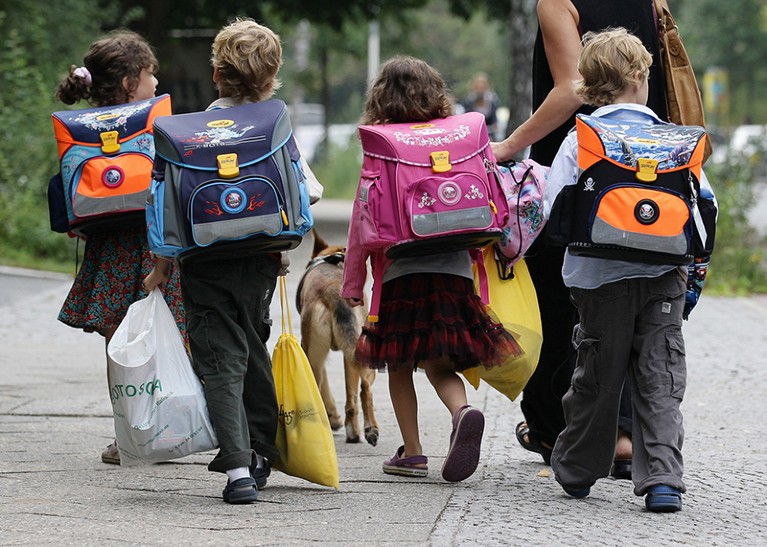
Education is one of the measures now used by the World Bank to assess a nation’s human capital.Credit: Andreas Rentz/Getty
The surprise 2014 global bestseller Capital in the Twenty-First Century, written by French economist Thomas Picketty, highlighted the role of wealth — rather than earnings — in the way that money makes the world go around. But Picketty chose to play down an important part of the system: human capital, the economic value derived from the knowledge, skills and abilities that enable people to perform paid work.
How to include human capital in analyses is as much a political as an economic problem: critics argue that the concept creates a false equivalence between having skills and having money, which plays down financial inequality. Supporters insist that it’s a genuine measure of the potential of individuals, populations and nations, and so a way to indicate their intrinsic value.
The World Bank has now reignited the debate. Earlier this month, it released its much-anticipated Human Capital Index (see go.nature.com/2cwyqqd), which ranks 157 nations according to measures of investment in their people. The bank’s measure is relatively simple, constructed from data on child survival and growth, years of primary and secondary schooling, and health. A country can achieve a perfect score if all children born today can expect to survive to 60 without impaired growth and development — resulting from poor nutrition, repeated infection or inadequate psychosocial stimulation, and measured by ratios of height and age — and can expect to have received 14 years of good-quality schooling by age 18.
The index is based on the assumption that a country’s economic productivity is tied to the knowledge and abilities of its people. It followed the release, two weeks earlier, of the results of a parallel (but separate) academic exercise by the Institute for Health Metrics and Evaluation at the University of Washington in Seattle (S. S. Lim et al. Lancet 392, 1217–1234; 2018).
The World Bank hopes its new index will mimic the success of its national “ease of doing business” ranking, which has focused government efforts around the world to reduce corruption and encourage outside investment as a way to secure a higher placing than their rivals and competitors. The bank wants to demonstrate how measures of education and health are linked to the productivity and prosperity of a country, assuming that investing in human capital through education and health systems can yield rapid development. In short, it wants to push countries to make things better for their people — and their human capital ranking. It has certainly managed to draw attention: Indian officials immediately protested against their country’s low ranking, and government officials there say they will ignore what they argue to be a simplistic and misleading measure.
Top scorers on the World Bank list include Singapore, South Korea and Japan, whereas many African countries, including Mali, Nigeria and Liberia, performed poorly and were near the bottom of the index.
The Institute for Health Metrics and Evaluation based its ranking of 195 countries on similar factors, but incorporated more measures of health and education, and used different data sources and methods. Finland, Iceland and Denmark top its charts, which cover the period from 1990 to 2016. During this time, the United States tumbled from 6th to 27th place, largely owing to minimal progress in educational attainment.
Few would argue against the goal of encouraging better health and education. And perhaps by framing these needs in terms of economic returns and tapping into the political desire to climb the leader boards, these measures might succeed in having a greater impact on decision-makers than do simple appeals to the intrinsic good. For example, one way to improve a country’s position would be for it to reduce gender inequality in years of schooling.
But any metric — be it a university ranking or standardized mathematics testing — is selective and must be interpreted appropriately. Too often it becomes a convenient proxy, leading to inferences of quality for which it was never intended, and distorting reality. As in most analyses of this type, these indices are only as good as the data that underlie them. There is a huge range in the quality and quantity of data on both health and education across countries. And although deductions about the exact effects of health outcomes and education on economic productivity are based on research, the true relationships are unclear for the range of countries and contexts to which the Human Capital Index is being applied. Critics are right to point out that a national score does not account for regional differences in a country.
Scientists can play a part here, to ensure that indices such as these become the credible motivators that they are intended to be. More and better data on indicators of health and educational outcomes will improve the accuracy of the indices. More research on rigorous ways to capture other determinants of human capital, and on their relationship to health, prosperity and well-being, will enrich our understanding of how to reach global development goals. Nature recognizes the need for such work to help inform policymakers and make their efforts more evidence-based. As such, we encourage submissions of high-quality data and analysis addressing knowledge gaps in assessing and improving human health and well-being.

 Mapping local variation in educational attainment across Africa
Mapping local variation in educational attainment across Africa
 Mapping child growth failure in Africa between 2000 and 2015
Mapping child growth failure in Africa between 2000 and 2015
 Science must help to make city living sustainable
Science must help to make city living sustainable


